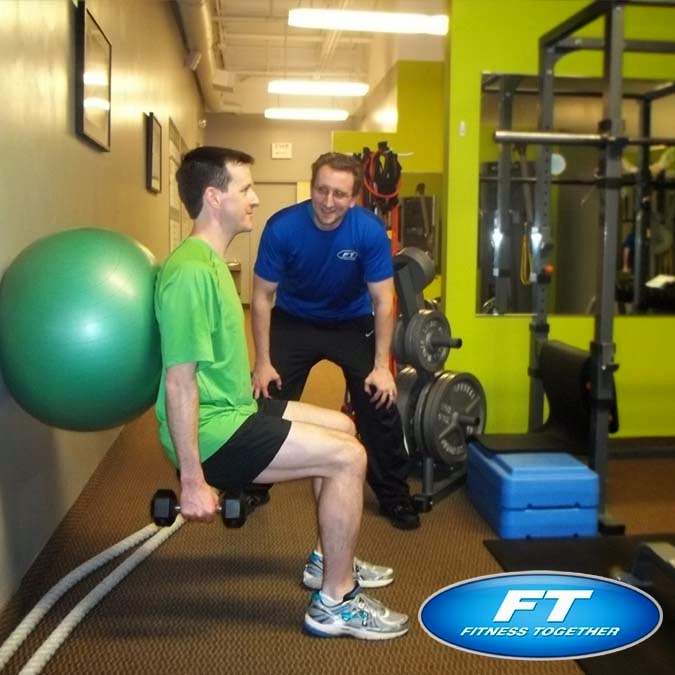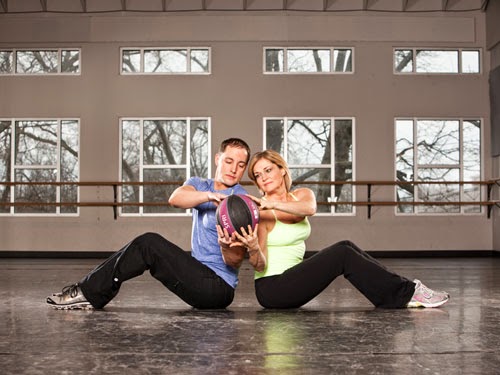Setting a Good Fitness Example for Your Kids
Kids are like sponges that absorb every attitude,
approach and response they see from their parents as they go through their
daily lives. When it comes to living a healthy and fitness-oriented lifestyle,
kids can be one of the best indications of how important eating healthy and
exercising regularly is to their parents.
Making a healthy lifestyle more of a priority for your family starts with parents leading the way and setting good fitness examples for their kids.
Lead By Example
There are so many situations in school, life and family in which parents leading by example is important to successfully teach kids how to make good choices. But it’s crucial for parents to practice what they preach if they want to make a healthy lifestyle a priority that sticks with their children throughout their lives.
Kids -- especially when they’re young -- naturally want to emulate their parents and won’t think twice about going for a walk at night instead of watching television if that’s what their parents do. Getting out and getting active yourself is one of the most important first steps to incorporating fitness into a kid’s lifestyle.
“If your kids see that you’re making a conscious effort to be healthy regularly, they will eventually notice the importance without you ever having to talk to them about it,” advises Kelly Bailey, personal trainer at Fitness TogetherBrecksville. “Let them catch you in the act of being fit, whether it’s during meal preparation, going for a run or writing down the workout that you’re about to do. If you’re about to exercise and they ask for something, tell them to wait because this is your exercise time.”
Make It a Habit
Exercising and eating healthy regularly becomes less of a struggle with your younger ones when it becomes a regular routine in your family’s daily life. Schedule time every day to do something active as a family -- even if it’s just 15 minutes at the beginning or end of your day -- so that fitness becomes something everyone in your family does without having to think about it.
By setting aside designated workout time, you are showing your kids that exercising is a priority and you’re making a point to instill healthy habits for you and your family.
“I think that it is important to talk to your kids about exercising because it’s a habit that you want them to form early,” advises Bailey. “I don’t really think you need to approach them about it. It’s one of those topics that you need to show the importance of by leading by example.”
Eating healthy also can become a habit if you minimize the junk food that comes into your house and maximize healthy food choices in your pantry and refrigerator. Remember, you’re the parent and you ultimately control the food that comes into your house. Make healthy food choices a priority for you and your family. Encourage your children to become involved in the menu planning and grocery shopping so they can experience what healthy eating looks like and be prepared to make their own healthy food choices as they get older.
“When it comes to eating healthy, find things that they actually like and make sure that those things are always available,” continues Bailey. “Sit down with your kids and come up with a weekly snack menu. This will help plant the idea of meal planning and also ensure that your kids will like the snacks that you are buying them.”
Discover What Interests Your Children
Fitting a square peg into a round hole never works when it comes to construction. So when you’re building your children’s interest in working out make sure that you don’t force them into doing an activity that they aren’t interested in.
One of the best approaches to encouraging children to become more active is to make sure that the activity they try aligns with their personality, desires and interests. Letting children take the lead on discovering what they enjoy will help make incorporating fitness into their lives easier and more rewarding.
Also, it’s important to be flexible as children might need to try out a few different activities before settling on what they enjoy. And even if the activity isn’t your first choice or interest as a parent, support your children in whatever direction they head.
“The most important thing for parents to realize when trying to encourage a child to work out is that it has to be their decision,” explains Bailey. “If you try and force fitness into their lives and it’s not their decision, it will become a chore and that isn’t how it’s supposed to be. Find a way to make it fun for them and I promise that it will stick.”
Have Fun With It
Having fun is the name of the game, both in life and in exercise. Neither adults nor children want to continue doing something if they aren’t enjoying it. With any exercise, it’s important to make being active fun for your kids and, your family.
Don’t be afraid to get a little silly with your exercises by making up games along the way to spice up the experience. And look for ways that you can make a fun activity your kids already like –- even playing video games -– more active by throwing in some victory laps around the house after completing a hard level or defeating a boss. When you make exercise fun, it becomes less daunting and less of an issue for you and your kids.
“It’s important to make family time more active,” says Kelly. “Go to the park instead of staying in or go bowling instead of watching family TV shows.”
Take the time today to make fitness a priority for you, your kids and your family. By supporting your children to live a more healthy and fit lifestyle, you’re dedicating yourself and your family to living better, stronger and more fulfilling lives.
Making a healthy lifestyle more of a priority for your family starts with parents leading the way and setting good fitness examples for their kids.
Lead By Example
There are so many situations in school, life and family in which parents leading by example is important to successfully teach kids how to make good choices. But it’s crucial for parents to practice what they preach if they want to make a healthy lifestyle a priority that sticks with their children throughout their lives.
Kids -- especially when they’re young -- naturally want to emulate their parents and won’t think twice about going for a walk at night instead of watching television if that’s what their parents do. Getting out and getting active yourself is one of the most important first steps to incorporating fitness into a kid’s lifestyle.
“If your kids see that you’re making a conscious effort to be healthy regularly, they will eventually notice the importance without you ever having to talk to them about it,” advises Kelly Bailey, personal trainer at Fitness TogetherBrecksville. “Let them catch you in the act of being fit, whether it’s during meal preparation, going for a run or writing down the workout that you’re about to do. If you’re about to exercise and they ask for something, tell them to wait because this is your exercise time.”
Make It a Habit
Exercising and eating healthy regularly becomes less of a struggle with your younger ones when it becomes a regular routine in your family’s daily life. Schedule time every day to do something active as a family -- even if it’s just 15 minutes at the beginning or end of your day -- so that fitness becomes something everyone in your family does without having to think about it.
By setting aside designated workout time, you are showing your kids that exercising is a priority and you’re making a point to instill healthy habits for you and your family.
“I think that it is important to talk to your kids about exercising because it’s a habit that you want them to form early,” advises Bailey. “I don’t really think you need to approach them about it. It’s one of those topics that you need to show the importance of by leading by example.”
Eating healthy also can become a habit if you minimize the junk food that comes into your house and maximize healthy food choices in your pantry and refrigerator. Remember, you’re the parent and you ultimately control the food that comes into your house. Make healthy food choices a priority for you and your family. Encourage your children to become involved in the menu planning and grocery shopping so they can experience what healthy eating looks like and be prepared to make their own healthy food choices as they get older.
“When it comes to eating healthy, find things that they actually like and make sure that those things are always available,” continues Bailey. “Sit down with your kids and come up with a weekly snack menu. This will help plant the idea of meal planning and also ensure that your kids will like the snacks that you are buying them.”
Discover What Interests Your Children
Fitting a square peg into a round hole never works when it comes to construction. So when you’re building your children’s interest in working out make sure that you don’t force them into doing an activity that they aren’t interested in.
One of the best approaches to encouraging children to become more active is to make sure that the activity they try aligns with their personality, desires and interests. Letting children take the lead on discovering what they enjoy will help make incorporating fitness into their lives easier and more rewarding.
Also, it’s important to be flexible as children might need to try out a few different activities before settling on what they enjoy. And even if the activity isn’t your first choice or interest as a parent, support your children in whatever direction they head.
“The most important thing for parents to realize when trying to encourage a child to work out is that it has to be their decision,” explains Bailey. “If you try and force fitness into their lives and it’s not their decision, it will become a chore and that isn’t how it’s supposed to be. Find a way to make it fun for them and I promise that it will stick.”
Have Fun With It
Having fun is the name of the game, both in life and in exercise. Neither adults nor children want to continue doing something if they aren’t enjoying it. With any exercise, it’s important to make being active fun for your kids and, your family.
Don’t be afraid to get a little silly with your exercises by making up games along the way to spice up the experience. And look for ways that you can make a fun activity your kids already like –- even playing video games -– more active by throwing in some victory laps around the house after completing a hard level or defeating a boss. When you make exercise fun, it becomes less daunting and less of an issue for you and your kids.
“It’s important to make family time more active,” says Kelly. “Go to the park instead of staying in or go bowling instead of watching family TV shows.”
Take the time today to make fitness a priority for you, your kids and your family. By supporting your children to live a more healthy and fit lifestyle, you’re dedicating yourself and your family to living better, stronger and more fulfilling lives.
© 2014 Fitness Together, Inc. All
Rights Reserved. Powered by Fusionbox.
About | Contact | Franchise | Suppliers | History | Leadership | NutritionTogether |Sitemap | PrivacyPolicy | TermsofUse | Facebook | YouTube | Twitter | Linkedin







